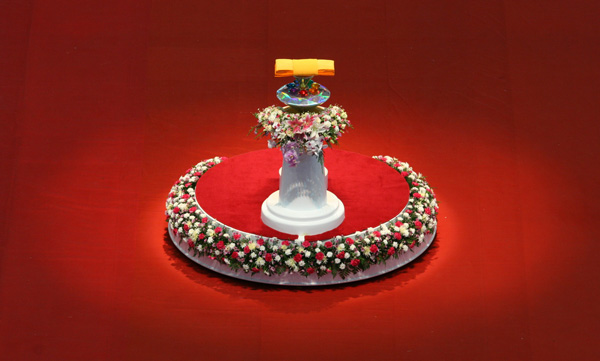Kathina
Kathina Ceremony
At the end of Buddhist lent, it is the time of robe offering ceremony, Kathina. The Kathina ceremony comes every year and takes place in all temples across the country.
Kathina means embroidery frame which monks use to sew their robes; also it means the equipment for monks to get a new robe after having been used for a year. At the beginning, Lord Buddha only allowed Bhikkhus (Buddhist monks) to use only cloths remaining on cadavers of dead bodies. This is because Lord Buddha wanted Bhikkhus to live a simple life by understanding the true and only purpose of clothing; to keep the wearer comfortable and to provide protection from sunburn, wind damage or insect disturbance. However, it was not easy to find the abandoned clothes especially when there were more Bhikkhus. In addition, there were complicated processes from searching for peices of cloths, tailor them and dye them. Some laypeople knew this difficulty and tried to offer monks a new robe. Thus, the Lord Buddha allowed monks to take a new robe from laypeople at the Kathina ceremony.

The Kathina ceremony is done by offering the Kathna’s robes among the assembly of the monks in that temple. The abbot or the chief monk of that temple will unanimously arrange these robes to monks who have qualifications to receive Kathina; the qualifications are those who take a full vassa (three months rain retreat) in that temple, that temple must have at least five monks staying during that vassa. The Kathina will be arranged within one month after the end of Buddhist lent; thus, the Kathina ceremony is not the normal ceremony which can be taken place in any time but it is limited.
The Kathina is the jubilant moment which all Buddhists really want to meet, as it happened in the past in the story of Tinnapala, the gardener. In the lifetime of Buddha Kasapa, the previous Buddha’e eon, there was a nameless pauper who worked in the garden. People in that time called him Tinapala, it means the gardener. He worked for only daily support such as foods and beverages in a millionaire’s house. At the end of Buddhist lent, the millionaire wanted to offer robes in Kathina ceremony, then, he told his pupils to follow. Tinnapla heard that news and wanted to offer some robes but he did not even have a cloth himself. So, he sold his last cloth which he was wearing and able to buy only a needle and a spoon of thread to be his necessities for the monks. Then he wore leaves as a cloth. When the millionaire knew his action, instead of blaming on him but he praised him with his delight. The Amarindra Sakka, King of Tavatimsa heaven realm, heard his good deed then appeared in front of him and praised him with the wishes.
In stead of wishing to be rich or wealthy, Tinnaplay wished four things; he wished himself not to harm any females by any actions, not to be parsimonious, not to have fool association, but to have a noble wife. After the Amarindara blessed him, the king of the country heard his good deed and called him to appear for an audience and asked him share some of his merit. With his sharing merit to the king, he was rewarded by the king a lot of properties. At the last day of his breath, he reappeared in the heaven and was born in this Buddha’s eon, The Gotama Buddha, the present Buddha’s lifetime. With his merit cultivated from his past life, he could attain the Arahanthood and completed the Nirvana.

